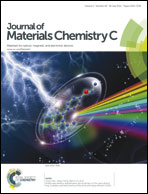Ambipolar organic semiconductors with cascades of energy levels for generating long-lived charge separated states: a donor–acceptor1–acceptor2 architectural triarylamine dye†
Abstract
A donor–acceptor1–acceptor2 architectural 4-styryltriphenyl amine-based organic semiconductor was synthesized for solar cell applications. Sequential electron transfers together with effective hole transfer lead to a charge separated state lifetime of 650 ns, therefore boosting the short circuit current and efficiency of single layer organic photovoltaic cells.


 Please wait while we load your content...
Please wait while we load your content...